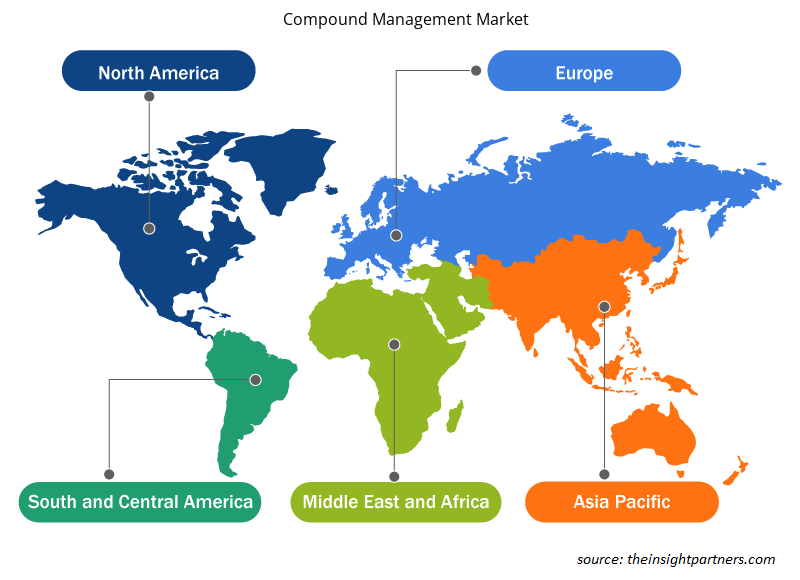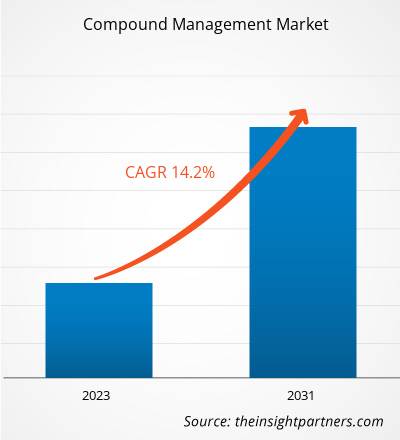Der Compound-Management-Markt soll von 369,1 Millionen US-Dollar im Jahr 2023 auf 950,14 Millionen US-Dollar im Jahr 2031 anwachsen. Der Markt soll in den Jahren 2023–2031 eine durchschnittliche jährliche Wachstumsrate (CAGR) von 14,20 % verzeichnen. Zunehmende Outsourcing-Aktivitäten im Zusammenhang mit Compound Management und die wachsende Biobanking- oder Biopharmaindustrie befeuern den Compound-Management-Markt. Die Verwaltung chemischer Bibliotheken, einschließlich Datenbanken und Wiederherstellung veralteter Chemikalien, Aktualisierung chemischer Informationen usw., ist stark gefragt. Compound Management umfasst auch die effektive Pflege chemischer Bibliotheken und biologischer Proben, um die allgemeine Sicherheit, Reinheit, Haltbarkeit und andere kritische Aspekte der Proben zu verbessern, was ein treibender Faktor für das Marktwachstum ist.CAGR of 14.20% in 2023–2031. Increasing outsourcing activities related to compound management and the growing biobanking or biopharmaceutical industry are fueling the compound management market. The management of chemical libraries, includes databases and restoring outdated chemicals, updating chemical information etc is in high demand. Compound management also involves effectively maintaining chemical libraries and biological samples to improve the overall safety, purity, shelf life, and other critical aspects of samples which is a boosting factor for market growth.
Compound-Management-Marktanalyse
Zunehmende F&E-Aktivitäten im Zusammenhang mit Compound Management sind einer der Hauptfaktoren, die das Marktwachstum antreiben. Steigende Forschungs- und Entwicklungsanstrengungen (F&E) und eine steigende Anzahl von F&E-Pipelines sind ein weiterer wichtiger Antriebsfaktor. Beispielsweise umfasst die F&E-Pipeline im Jahr 2023 22.000 Medikamente, während die Anzahl der Medikamente in der Pipeline im Jahr 2022 laut den Daten aus dem Pharma Annual Review 2022 bei etwa 20.109 lag. Darüber hinaus sind Verbindungsbibliotheken (Sammlungen verschiedener chemischer Verbindungen) aufgrund steigender F&E-Aktivitäten in der Pharma- und Biotechnologiebranche stärker gefragt. Diese Bibliotheken bieten Tools zum Screening und zur Identifizierung potenzieller Arzneimittelkandidaten. Daher wird erwartet, dass sich das Marktwachstum des Compound Managements mit zunehmender F&E und der Einführung von Verbindungsbibliotheken in naher Zukunft weiter verstärken wird.
Compound-Management-Marktübersicht
Nordamerika ist der größte Markt für das Wachstum des Compound-Management-Marktes, wobei die USA den größten Marktanteil halten, gefolgt von Kanada. Der nordamerikanische Compound-Management-Markt wird von der großen Pharma- und Biopharmaindustrie angetrieben. Nordamerikanische Pharmaunternehmen sind in der Arzneimittelforschung tätig und müssen riesige chemische Bibliotheken pflegen. Um die Produktivität fortschrittlicher Medikamente und Biologika aufrechtzuerhalten, haben große Pharma- und Biopharmaunternehmen daher mit dem Bau von Compound-Management-Einrichtungen begonnen. Daher wird erwartet, dass dieser Faktor das allgemeine Marktwachstum ankurbelt.
Passen Sie diesen Bericht Ihren Anforderungen an
Sie erhalten kostenlos individuelle Anpassungen an jedem Bericht, einschließlich Teilen dieses Berichts oder einer Analyse auf Länderebene, eines Excel-Datenpakets sowie tolle Angebote und Rabatte für Start-ups und Universitäten.
-
Holen Sie sich die wichtigsten Markttrends aus diesem Bericht.Dieses KOSTENLOSE Beispiel umfasst eine Datenanalyse von Markttrends bis hin zu Schätzungen und Prognosen.
Treiber und Chancen auf dem Compound-Management-Markt
Steigende Nachfrage nach Biologika und beschleunigte Arzneimittelentdeckung begünstigen den MarktBiologics and Accelerating Drug Discovery Favors the Market
Robuste Pharmakovigilanzsysteme sind von entscheidender Bedeutung, um die Komplexität der Sicherheitsdaten und die Herausforderungen bei der Erkennung unerwünschter Arzneimittelwirkungen (UAW) sowohl bei innovativen Biologika als auch bei Biosimilars zu bewältigen. Darüber hinaus ist der Prozess der Arzneimittelentdeckung und -entwicklung ein kostspieliger, langwieriger und komplizierter Prozess und erfordert verschiedene fortschrittliche Techniken. Screening-Prozesse wie das Hochdurchsatz-Screening prüfen eine große Anzahl von Verbindungen mit einem biologischen Ziel. Daher wird erwartet, dass steigende Aktivitäten bei der Arzneimittelentdeckung das Marktwachstum im Bereich des Compound-Managements weiter ankurbeln werden.pharmacovigilance systems are critical to address the complexity of safety data and challenges in detecting Adverse Drug Reaction (ADRs), for both innovator biologics and biosimilars. Additionally, drug discovery process and development of a compound is a costly, lengthy, and complicated process and requires various advanced techniques. Screening process such as High throughput screening is screens a large number of compounds with a biological target. Hence, rising drug discovery activities is further expected to boost the market growth of compound management.
Expandierende Biopharma- und Pharmaunternehmen in Entwicklungsländern – eine Chance im Compound-Management-MarktBiopharma and Pharma Companies in Developing Countries– An Opportunity in the Compound Management Market
Entwicklungsländer sind ein wichtiger Knotenpunkt für Pharma- und Biotechnologieunternehmen, da diese Länder niedrige Arbeits- und Rohstoffkosten bieten. Aufgrund der oben genannten Faktoren ist die Nachfrage nach Compound Management in asiatischen Ländern gestiegen. Darüber hinaus konzentrieren sich die steigenden Mittel und Budgets dieser Unternehmen auf Compound Management. Die kostengünstige Auslagerung von Compound Management-Diensten in den Entwicklungsländern in Verbindung mit der steigenden Verbreitung chronischer und infektiöser Krankheiten schafft im Prognosezeitraum weitere Wachstumschancen für den Markt.
Segmentierungsanalyse des Compound-Management-Marktberichts
Wichtige Segmente, die zur Ableitung der Compound-Management-Marktanalyse beigetragen haben, sind Produkt und Dienstleistungen, Probentyp, Anwendung und Endbenutzer.
- Produkte und Dienstleistungen (Produkte und Dienstleistungen zur Verwaltung von Verbindungen/Proben), Probentyp (chemische Verbindungen und Bioproben), Anwendung (Arzneimittelentdeckung, Gensynthese und Biobanking) und Endbenutzer (Pharmaunternehmen, biopharmazeutische Unternehmen, Auftragsforschungsinstitute (CROs) und andere)
- Basierend auf den Produkten und Dienstleistungen ist der Compound-Management-Markt in Dienstleistungen und Compound-/Probenmanagementprodukte segmentiert. Die Compound-/Probenmanagementprodukte hatten im Jahr 2023 einen größeren Marktanteil.
- Nach Anwendung ist der Markt in Arzneimittelforschung, Gensynthese und Biobanking unterteilt. Die Arzneimittelforschung hielt im Jahr 2023 den größten Marktanteil.
- Basierend auf den Endverbrauchern ist der Markt in Pharmaunternehmen, Biopharmaunternehmen, Auftragsforschungsinstitute (CROs) und andere unterteilt. Die Pharmaunternehmen hielten im Jahr 2023 den größten Marktanteil.
Compound Management Marktanteilsanalyse nach Geografie
Der geografische Umfang des Compound-Management-Marktberichts ist hauptsächlich in fünf Regionen unterteilt: Nordamerika, Asien-Pazifik, Europa, Naher Osten und Afrika sowie Südamerika/Süd- und Mittelamerika. Nordamerika dominierte den Compound-Management-Markt. Das Marktwachstum des Compound-Managements ist auf die zunehmenden Anstrengungen der Pharmaunternehmen in den Bereichen Forschung und Entwicklung sowie auf die Präsenz von Biopharma- und Pharmaunternehmen auf dem Markt zurückzuführen. Darüber hinaus dürften technologische Fortschritte im Arzneimittelentdeckungsprozess ein wichtiger Wachstumsmotor für den Compound-Management-Markt in Nordamerika sein.
Compound-Management
Regionale Einblicke in den Compound-Management-Markt
Die regionalen Trends und Faktoren, die den Compound-Management-Markt während des Prognosezeitraums beeinflussen, wurden von den Analysten von Insight Partners ausführlich erläutert. In diesem Abschnitt werden auch die Compound-Management-Marktsegmente und die Geografie in Nordamerika, Europa, im asiatisch-pazifischen Raum, im Nahen Osten und Afrika sowie in Süd- und Mittelamerika erörtert.

- Erhalten Sie regionale Daten zum Compound-Management-Markt
Umfang des Compound Management-Marktberichts
| Berichtsattribut | Details |
|---|---|
| Marktgröße im Jahr 2023 | 369,1 Millionen US-Dollar |
| Marktgröße bis 2031 | 950,14 Millionen US-Dollar |
| Globale CAGR (2023 - 2031) | 14,20 % |
| Historische Daten | 2021-2022 |
| Prognosezeitraum | 2023–2031 |
| Abgedeckte Segmente |
Nach Produkt und Service
|
| Abgedeckte Regionen und Länder |
Nordamerika
|
| Marktführer und wichtige Unternehmensprofile |
|
Dichte der Marktteilnehmer im Compound-Management: Die Auswirkungen auf die Geschäftsdynamik verstehen
Der Compound-Management-Markt wächst rasant, angetrieben durch die steigende Endverbrauchernachfrage aufgrund von Faktoren wie sich entwickelnden Verbraucherpräferenzen, technologischen Fortschritten und einem größeren Bewusstsein für die Vorteile des Produkts. Mit steigender Nachfrage erweitern Unternehmen ihr Angebot, entwickeln Innovationen, um die Bedürfnisse der Verbraucher zu erfüllen, und nutzen neue Trends, was das Marktwachstum weiter ankurbelt.
Die Marktteilnehmerdichte bezieht sich auf die Verteilung der Firmen oder Unternehmen, die in einem bestimmten Markt oder einer bestimmten Branche tätig sind. Sie gibt an, wie viele Wettbewerber (Marktteilnehmer) in einem bestimmten Marktraum im Verhältnis zu seiner Größe oder seinem gesamten Marktwert präsent sind.
Die wichtigsten auf dem Compound-Management-Markt tätigen Unternehmen sind:
- WuXiAppTec
- Evotec
- Icagen
- TCG Biowissenschaften
- TTP LabTech
- Hamilton-Unternehmen
Haftungsausschluss : Die oben aufgeführten Unternehmen sind nicht in einer bestimmten Reihenfolge aufgeführt.

- Überblick über die wichtigsten Akteure auf dem Compound-Management-Markt
Neuigkeiten und aktuelle Entwicklungen zum Compound-Management-Markt
Der Compound-Management-Markt wird durch die Erhebung qualitativer und quantitativer Daten nach Primär- und Sekundärforschung bewertet, die wichtige Unternehmenspublikationen, Verbandsdaten und Datenbanken umfasst. Im Folgenden finden Sie eine Liste der Entwicklungen auf dem Compound-Management-Markt:
- SPT Labtech gab die Übernahme von BioMicroLab, einem Anbieter von Roboterautomatisierung, bekannt, um seine Kapazitäten im Bereich des automatischen Probenmanagements zu stärken. (Quelle: SPT Labtech, Pressemitteilung/Unternehmenswebsite/Newsletter, Februar 2021)
- Ziath, ein führender Anbieter von Lösungen für das Proben-/Verbindungsmanagement, hat eine neue Software namens Datapaq 3.18 vorgestellt, die das Acoustix-Modul auf einem Cube-, Mirage- oder Express-Röhrchenlesegerät ausführt. Das Produkt ist mit Labcyte Echo kompatibel, der neuesten Generation akustischer Dispenser. Es bietet eine höhere Geschwindigkeit und Effizienz als viele andere verfügbare Röhrchenlesegeräte. (Quelle: Ziath, Pressemitteilung/Unternehmenswebsite/Newsletter, Dezember 2020)
- Ein führendes Softwareunternehmen für automatisierte Prozesse und Laboranbindung, Biosero, wurde von BICO übernommen. BICO investiert innerhalb von drei Jahren bis zu 20 Millionen US-Dollar, um die kommerzielle Agenda von Biosero zu beschleunigen, in neue geografische Märkte zu expandieren und den aktuellen Auftragsbestand voll auszuschöpfen. (Quelle: Bico, Pressemitteilung/Unternehmenswebsite/Newsletter, Dezember 2020)
Abdeckung und Ergebnisse des Compound-Management-Marktberichts
Der Bericht „Compound-Management-Marktgröße und -Prognose (2021–2031)“ bietet eine detaillierte Analyse des Marktes, die die folgenden Bereiche abdeckt:
- Marktgröße und Prognose auf globaler, regionaler und Länderebene für alle wichtigen Marktsegmente, die im Rahmen des Projekts abgedeckt sind
- Marktdynamik wie Treiber, Beschränkungen und wichtige Chancen
- Wichtige Zukunftstrends
- Detaillierte PEST/Porters Five Forces- und SWOT-Analyse
- Globale und regionale Marktanalyse mit wichtigen Markttrends, wichtigen Akteuren, Vorschriften und aktuellen Marktentwicklungen
- Branchenlandschaft und Wettbewerbsanalyse, einschließlich Marktkonzentration, Heatmap-Analyse, prominenten Akteuren und aktuellen Entwicklungen
- Detaillierte Firmenprofile
- Historische Analyse (2 Jahre), Basisjahr, Prognose (7 Jahre) mit CAGR
- PEST- und SWOT-Analyse
- Marktgröße Wert/Volumen – Global, Regional, Land
- Branchen- und Wettbewerbslandschaft
- Excel-Datensatz
Aktuelle Berichte
Verwandte Berichte
Erfahrungsberichte
Grund zum Kauf
- Fundierte Entscheidungsfindung
- Marktdynamik verstehen
- Wettbewerbsanalyse
- Kundeneinblicke
- Marktprognosen
- Risikominimierung
- Strategische Planung
- Investitionsbegründung
- Identifizierung neuer Märkte
- Verbesserung von Marketingstrategien
- Steigerung der Betriebseffizienz
- Anpassung an regulatorische Trends























 Kostenlose Probe anfordern für - Compound-Management-Markt
Kostenlose Probe anfordern für - Compound-Management-Markt